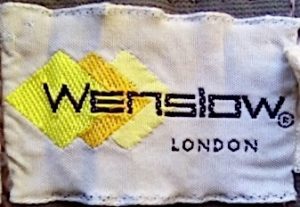Jack Lindsay (1931-2021) founded Wenslow in London in 1959 and was the principal designer. Born in Bethnal Green, his mother owned ladies dress shops and his father was a master tailor. He began his fashion career as a salesman for Meekers, a well-established menswear chain, at their Cheapside location, moving on to White’s – another upscale menswear retailer in Charing Cross Road, and finally to Brick’s, also a London retailer.
Named after the 1946 play “Winslow Boy” by Terence Rattigan, Wenslow was best known for its lace and ruffled men’s shirts, supplying them to the trendy Carnaby Street shops during the 1960s and 1970s. The company made trousers as well, under the Centavo brand. Originally a menswear manufacturer, it expanded to include children’s and womenswear, launching Miss Wenslow in 1968, and paying models like Jilly Johnson to advertise the brand by wearing its clothes on the Underground trains. Its international division, Wenslow Overseas, was also also created in 1968. Originally headquartered at 52a Blackstock Rd, Finsbury Park, by 1972, as the company grew, it relocated to 3/4, Wells Terrace, Finsbury Park, and finally to Fitzroy House, Abbot Street.
As the company flourished in the ’60s and ’70s, it made clothes for pop bands like The Mind Benders and TV personalities such as the wrestler Jackie Pallo. It is listed in the credits for the 1967 movie “Baby Love” for supplying Linda Hayden’s wardrobe. Eventually, the company went the way of so many other British manufacturers in the early 1980s that could not compete with cheaper goods made overseas. The company ceased trading in 1981.
Although Jack Lindsay retired from the clothing business, he was far from idle. In his 70s, he embarked on a successful career as an actor, appearing in numerous commercials, TV and films.
Below is an interview Jack Lindsay gave to his son Michael Lindsay on April 10, 2021:
“I started with £5 in my pocket as J. Lindsay and Company – buying some fabric and having it made up into shirts. I found a shirt maker – M Gold Manufacturer – through an advert in Menswear Magazine. I got talking to him and got friendly with him and he decided to make some shirts for me. I gave him a few lengths of fabric – all in cream, and he made about a dozen shirts – all size 15 1/2. Later, I took a stand at Earl’s Court Exhibition Center in London and that was the start of Wenslow. We were inundated! I had no plans, no ideas, but we were stormed! We had so many customers, while the man who had made the shirt samples for me also had his own stand, but his booth was empty. It was because of the designs I had made.
Originally, we had one machinist to start. Then we moved to the factory at Blackstock Road in Finsbury Park. It had 3 stories – we had the middle floor. Downstairs was a dry cleaners and upstairs a little dressmaker. We probably had about 10 employees in-house as well as several contractors making shirts for us. First, we worked with two factories in the UK, then expanded to Portugal, Hong Kong, Greece, India, and elsewhere. We would cut the fabric, send it to a factory to sew, then we would press the finished goods and pack them ourselves.
We were probably best known as “Wenslow Shirts”. One of my favorite designs was a turtleneck shirt that zipped up from the back. The zip was from the nape of the neck. When you turned it over, we’d put a little design so you could wear this polo shirt with a small emblem where your throat was.”
Written by Michael Lindsay, edited by VFG Staff

